标签:post attr 结果 img text 生效 port amp 传递
一、struts2是什么
1.概念
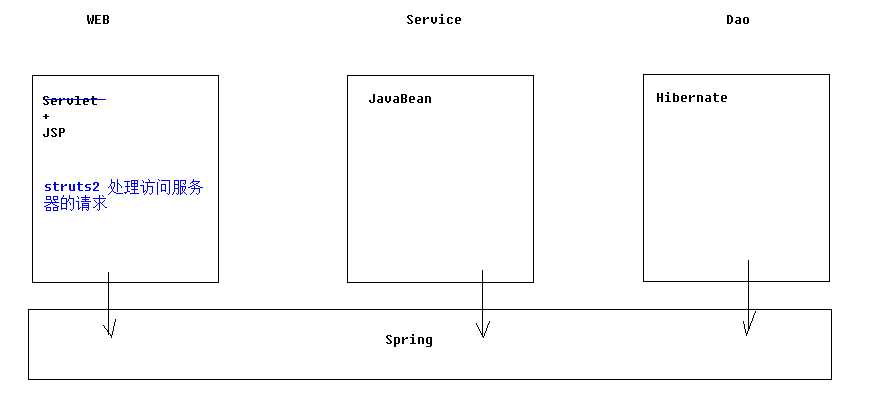
2.struts2使用优势以及历史
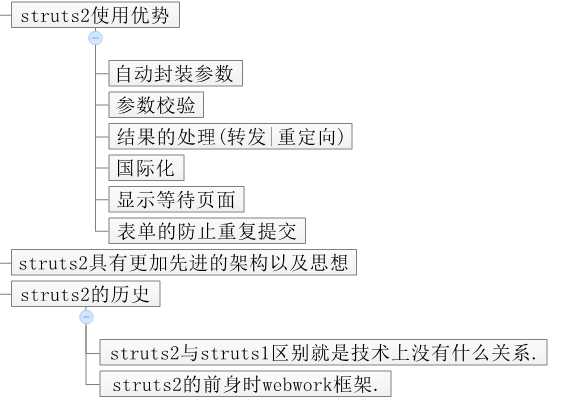
二、搭建struts2框架
1.导包
(解压缩)struts2-blank.war就会看到
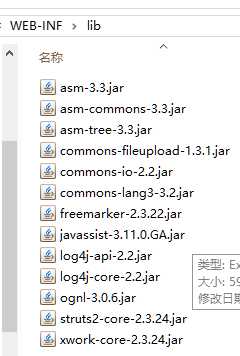
2.书写Action类

public class HelloAction { public String hello(){ System.out.println("hello world!"); return "success"; } }
3.书写src/struts.xml (记得加上dtd约束)

<?xml version="1.0" encoding="UTF-8"?> <!DOCTYPE struts PUBLIC "-//Apache Software Foundation//DTD Struts Configuration 2.3//EN" "http://struts.apache.org/dtds/struts-2.3.dtd"> <struts> <package name="hello" namespace="/hello" extends="struts-default" > <action name="HelloAction" class="cn.itheima.a_hello.HelloAction" method="hello" > <result name="success" type="dispatcher" >/hello.jsp</result> </action> </package> </struts>
4.将struts2核心过滤器配置到web.xml
filter-class记不住可以ctrl+shift+t 输入strutsPre来查找全类名

<!-- struts2核心过滤器 --> <filter> <filter-name>struts2</filter-name> <filter-class>org.apache.struts2.dispatcher.ng.filter.StrutsPrepareAndExecuteFilter</filter-class> </filter> <filter-mapping> <filter-name>struts2</filter-name> <url-pattern>/*</url-pattern> </filter-mapping>
5.测试

三、struts2访问流程&struts2架构
1.struts2架构
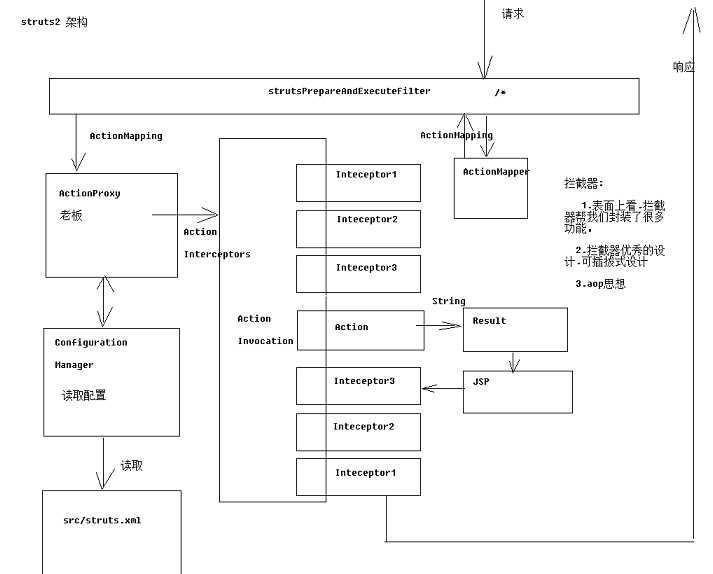
2.Aop编程(面向切面)
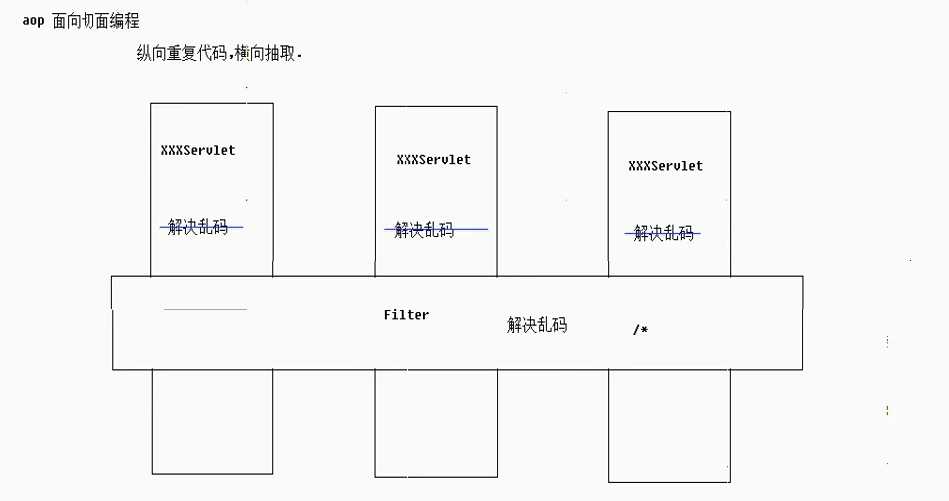
四、配置详解
1.struts.xml配置详解

<?xml version="1.0" encoding="UTF-8"?> <!DOCTYPE struts PUBLIC "-//Apache Software Foundation//DTD Struts Configuration 2.3//EN" "http://struts.apache.org/dtds/struts-2.3.dtd"> <struts> <!-- i18n:国际化. 解决post提交乱码 --> <constant name="struts.i18n.encoding" value="UTF-8"></constant> <!-- 指定反问action时的后缀名 http://localhost:8080/struts2_day01/hello/HelloAction.do --> <constant name="struts.action.extension" value="action"></constant> <!-- 指定struts2是否以开发模式运行 1.热加载主配置.(不需要重启即可生效) 2.提供更多错误信息输出,方便开发时的调试 --> <constant name="struts.devMode" value="true"></constant> <!-- package:将Action配置封装.就是可以在Package中配置很多action. name属性: 给包起个名字,起到标识作用.随便起.不能其他包名重复. namespace属性:给action的访问路径中定义一个命名空间 extends属性: 继承一个 指定包 abstract属性:包是否为抽象的; 标识性属性.标识该包不能独立运行.专门被继承 --> <package name="hello" namespace="/hello" extends="struts-default" > <!-- action元素:配置action类 name属性: 决定了Action访问资源名. class属性: action的完整类名 method属性: 指定调用Action中的哪个方法来处理请求 --> <action name="HelloAction" class="cn.itheima.a_hello.HelloAction" method="hello" > <!-- result元素:结果配置 name属性: 标识结果处理的名称.与action方法的返回值对应. type属性: 指定调用哪一个result类来处理结果,默认使用转发. 标签体:填写页面的相对路径 --> <result name="success" type="dispatcher" >/hello.jsp</result> </action> </package> <!-- 引入其他struts配置文件 --> <include file="cn/itheima/b_dynamic/struts.xml"></include> <include file="cn/itheima/c_default/struts.xml"></include> </struts>
2.struts2常量配置
2.1 struts2默认常量配置位置
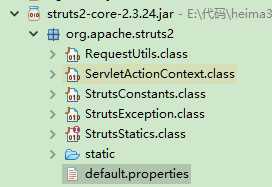
2.2 修改struts2常量配置(方式先后也是加载顺序)
方式1:src/struts.xml
<!-- i18n:国际化. 解决post提交乱码 --> <constant name="struts.i18n.encoding" value="UTF-8"></constant>
方式2:在src下创建struts.properties
struts.i18n.encoding=UTF8
方式3:在项目的web.xml中
<context-param> <param-name>struts.i18n.encoding</param-name> <param-value>UTF-8</param-value> </context-param>
顺序:

2.3 常量配置

<!-- i18n:国际化. 解决post提交乱码 --> <constant name="struts.i18n.encoding" value="UTF-8"></constant> <!-- 指定反问action时的后缀名 http://localhost:8080/struts2_day01/hello/HelloAction.do --> <constant name="struts.action.extension" value="action"></constant> <!-- 指定struts2是否以开发模式运行 1.热加载主配置.(不需要重启即可生效) 2.提供更多错误信息输出,方便开发时的调试 --> <constant name="struts.devMode" value="true"></constant>
3.struts2配置的进阶
3.1动态方法调用

<!-- 配置动态方法调用是否开启常量 默认是关闭的,需要开启 --> <constant name="struts.enable.DynamicMethodInvocation" value="true"></constant>

<!-- 动态方法调用方式2:通配符方式 使用{1} 取出第一个星号通配的内容 --> <action name="Demo1Action_*" class="cn.itheima.b_dynamic.Demo1Action" method="{1}" > <result name="success" >/hello.jsp</result> </action>
3.2struts2中的默认配置

<package name="default" namespace="/default" extends="struts-default" > <!-- 找不到包下的action,会使用Demo2Action作为默认action处理请求 --> <default-action-ref name="Demo2Action"></default-action-ref> <!-- method属性:execute --> <!-- result的name属性:success --> <!-- result的type属性:dispatcher 转发 --> <!-- class属性:com.opensymphony.xwork2.ActionSupport --> <action name="Demo2Action" > <result >/hello.jsp</result> </action> </package>
五、action类详解
Action类的书写方式

//方式1: 创建一个类.可以是POJO //POJO:不用继承任何父类.也不需要实现任何接口. //使struts2框架的代码侵入性更低. public class Demo3Action { }

//方式2: 实现一个接口Action // 里面有execute方法,提供action方法的规范. // Action接口预置了一些字符串.可以在返回结果时使用.为了方便 public class Demo4Action implements Action { @Override public String execute() throws Exception { return null; } }

//方式3: 继承一个类.ActionSupport // 帮我们实现了 Validateable, ValidationAware, TextProvider, LocaleProvider . //如果我们需要用到这些接口的实现时,不需要自己来实现了. public class Demo5Action extends ActionSupport{ }
六、练习:客户列表
图解:

实现:

public class CustomerAction extends ActionSupport { private CustomerService cs = new CustomerServiceImpl(); public String list() throws Exception { //1 接受参数 String cust_name = ServletActionContext.getRequest().getParameter("cust_name"); //2 创建离线查询对象 DetachedCriteria dc =DetachedCriteria.forClass(Customer.class); //3 判断参数拼装条件 if(StringUtils.isNotBlank(cust_name)){ dc.add(Restrictions.like("cust_name", "%"+cust_name+"%")); } //4 调用Service将离线对象传递 List<Customer> list = cs.getAll(dc); //5 将返回的list放入request域.转发到list.jsp显示 ServletActionContext.getRequest().setAttribute("list", list); return "list"; } }

public List<Customer> getAll(DetachedCriteria dc) { Session session = HibernateUtils.getCurrentSession(); //打开事务 Transaction tx = session.beginTransaction(); List<Customer> list = customerDao.getAll(dc); //关闭事务 tx.commit(); return list; }

public List<Customer> getAll(DetachedCriteria dc) { //1 获得session Session session = HibernateUtils.getCurrentSession(); //2 将离线对象关联到session Criteria c = dc.getExecutableCriteria(session); //3 执行查询并返回 return c.list(); }
JAVAEE学习——struts2_01:简介、搭建、架构、配置、action类详解和练习:客户列表
标签:post attr 结果 img text 生效 port amp 传递
原文地址:http://www.cnblogs.com/xieyupeng/p/6962264.html